Headspace System Analysis: Cloud Computing, SDLC, and Security
VerifiedAdded on 2022/10/19
|10
|2239
|7
Report
AI Summary
This report presents a system analysis of Headspace, a platform likely focused on mental wellness or related services. The analysis covers various aspects, including non-functional requirements like usability, reliability, performance, and security. It explores cloud-based solutions, specifically favoring Platform as a Service (PaaS) due to its advantages in automatic software updates and cost-effectiveness. The report also delves into the Software Development Life Cycle (SDLC), comparing predictive and adaptive approaches, and ultimately recommending the predictive SDLC for the Headspace project, citing its suitability for projects with known requirements and specific timelines. The document also includes a discussion of security considerations, emphasizing the need for robust measures to prevent cyber and physical attacks. The report also includes references to relevant sources.
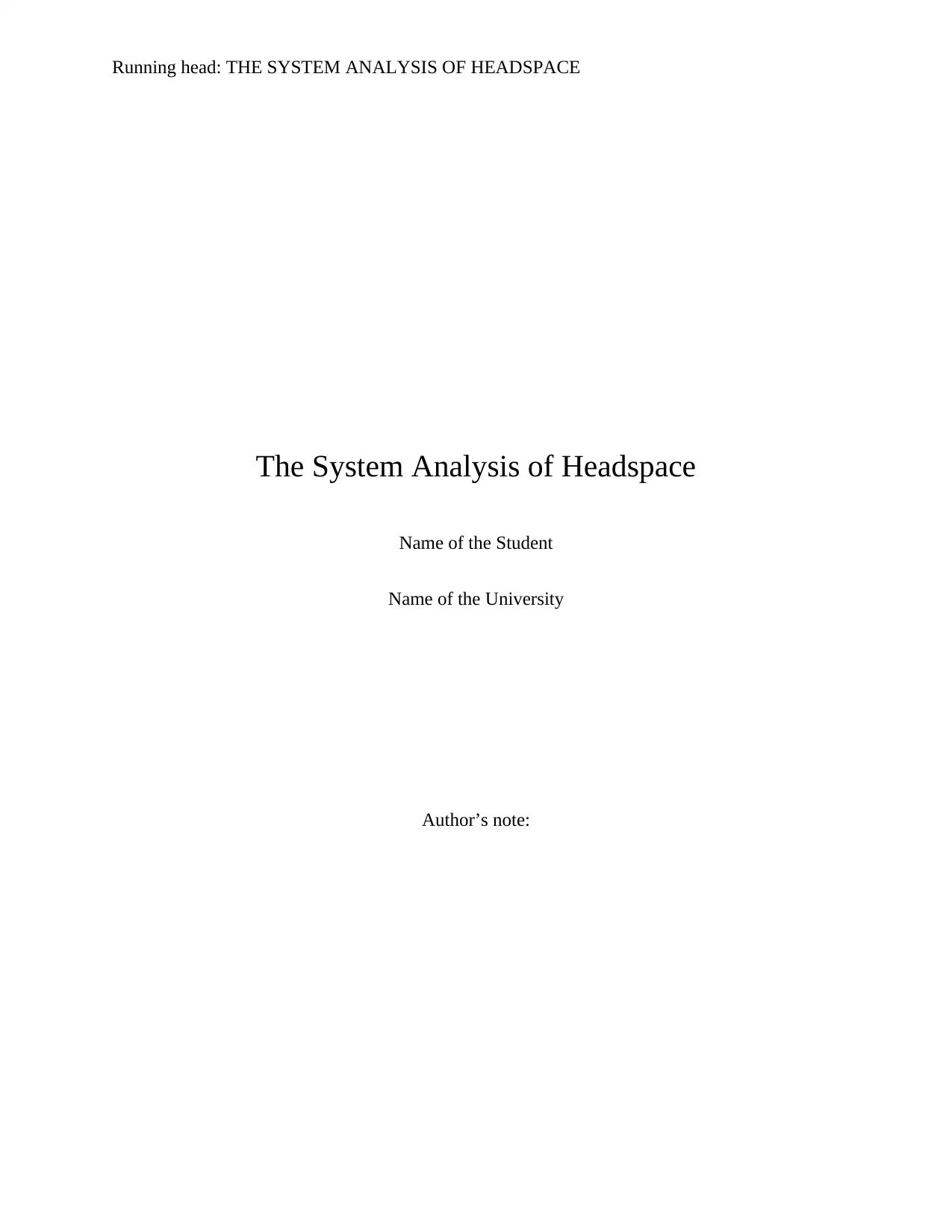
Running head: THE SYSTEM ANALYSIS OF HEADSPACE
The System Analysis of Headspace
Name of the Student
Name of the University
Author’s note:
The System Analysis of Headspace
Name of the Student
Name of the University
Author’s note:
Paraphrase This Document
Need a fresh take? Get an instant paraphrase of this document with our AI Paraphraser
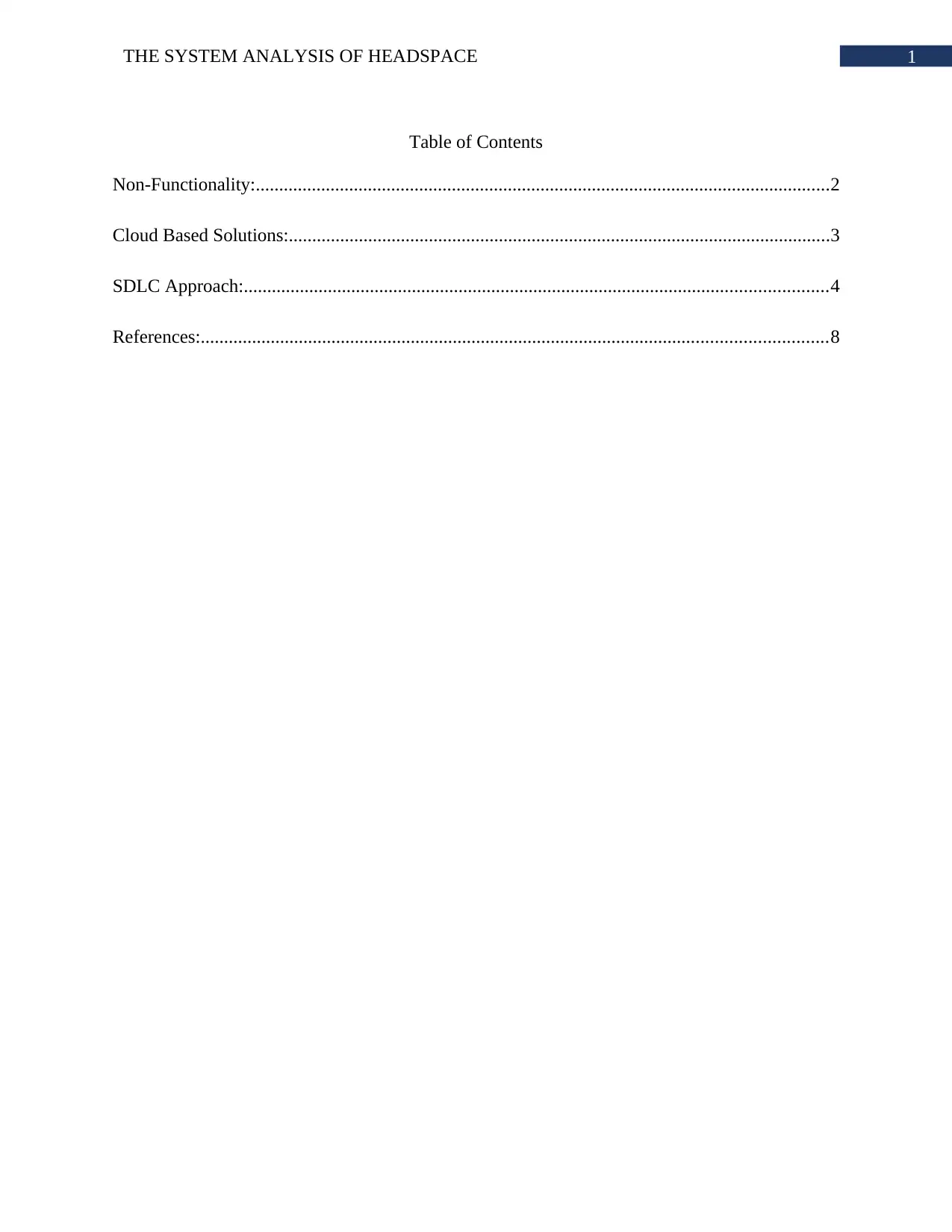
1THE SYSTEM ANALYSIS OF HEADSPACE
Table of Contents
Non-Functionality:...........................................................................................................................2
Cloud Based Solutions:....................................................................................................................3
SDLC Approach:.............................................................................................................................4
References:......................................................................................................................................8
Table of Contents
Non-Functionality:...........................................................................................................................2
Cloud Based Solutions:....................................................................................................................3
SDLC Approach:.............................................................................................................................4
References:......................................................................................................................................8

2THE SYSTEM ANALYSIS OF HEADSPACE
Non-Functionality:
Functionality: The system will allows the users to be registered into the system. The
registration is done by the admin. The administrator of the system will have a separate screen for
registering all kinds of users. The system will have login screen for different users. Each user
will be provide login id and password. Using these data, the user have to login to the system.
Only the authorized user can record patient data and story into the system. Patient data will be
stored in system and later shared with doctors and other authorized users.
Usability: The usability considers that how effectively the system can be utilized to get
wanted capacities and data. The usability is firmly associated with the human PC cooperation.
The system ought to have a menu driven methodology. Each page of the system ought to have a
connection to return to past page or principle page. The system should demonstrate appropriate
messages and cautions to the client at expected area (Diwan, 2016). On the off chance that a
client is committing error, at that point system ought to give legitimate adjust. Including
indications in different segments enables the system to be increasingly successful regarding
client fulfillment. The structure of the system will be straightforward. The liveliness impacts will
be straightforward and defended. Consistency is another pivotal piece of usability. The system
ought to have same topic through every one of the areas. Regardless of which segment the client
opens, he ought to immediately remember it as the Headspace system. The shading blend will be
same alongside the header and footer. The documentation of the system is basic in the event that
any issue happens or system alteration is required. Responsiveness may not be an exceedingly
required non-functional necessity of the system, however it can add greater usability to the
system. On the off chance that the system will be responsive, at that point the client can get to
the system from any gadget.
Non-Functionality:
Functionality: The system will allows the users to be registered into the system. The
registration is done by the admin. The administrator of the system will have a separate screen for
registering all kinds of users. The system will have login screen for different users. Each user
will be provide login id and password. Using these data, the user have to login to the system.
Only the authorized user can record patient data and story into the system. Patient data will be
stored in system and later shared with doctors and other authorized users.
Usability: The usability considers that how effectively the system can be utilized to get
wanted capacities and data. The usability is firmly associated with the human PC cooperation.
The system ought to have a menu driven methodology. Each page of the system ought to have a
connection to return to past page or principle page. The system should demonstrate appropriate
messages and cautions to the client at expected area (Diwan, 2016). On the off chance that a
client is committing error, at that point system ought to give legitimate adjust. Including
indications in different segments enables the system to be increasingly successful regarding
client fulfillment. The structure of the system will be straightforward. The liveliness impacts will
be straightforward and defended. Consistency is another pivotal piece of usability. The system
ought to have same topic through every one of the areas. Regardless of which segment the client
opens, he ought to immediately remember it as the Headspace system. The shading blend will be
same alongside the header and footer. The documentation of the system is basic in the event that
any issue happens or system alteration is required. Responsiveness may not be an exceedingly
required non-functional necessity of the system, however it can add greater usability to the
system. On the off chance that the system will be responsive, at that point the client can get to
the system from any gadget.
⊘ This is a preview!⊘
Do you want full access?
Subscribe today to unlock all pages.

Trusted by 1+ million students worldwide

3THE SYSTEM ANALYSIS OF HEADSPACE
Reliability: The system should maintain data integrity. Every data will be analyzed and
only authentic data will be entered into the system database.
Performance: How quickly a process is conducted by the system is fundamental as it
sway on the defer time of procedures. The system ought to have the option to reaction to client
demand inside 2 seconds and most extreme or 5 seconds. The information ought to be glided
continuously so every client will be refreshed about new information (Wahaballa et al., 2015).
The system will be sufficiently brilliant to utilize negligible measure of assets. A solitary unified
information will be utilized for each part with the goal that information simultaneousness can be
overseen.
Security: The system needs to be secure enough to prevent most of the cyber-attacks. The
system will also be secure from the physical attacks.
Review of Cloud Based Solutions:
Cloud computing the process of providing service to the customer over the internet or any
other similar network from a remotely located server. The user can access the service through a
web-based system or application installed in the device. Cloud computing is the present and
future of technology (Almorsy, Grundy & Muller, 2016). The cloud computing can be
categorized into three parts such as Infrastructure as a Service, Platform as a Service and
Software as a Service. Each of these three has its distinctive feature. However, the Platform as a
Service is selected as the most suitable cloud environment for Headspace system.
The Platform as a Service or PaaS can be considered as the service model which allows a
user to rent space for storing data on a server and developing application on the same server to
process those data. The PaaS comes with a platform which allows the users to create a web
Reliability: The system should maintain data integrity. Every data will be analyzed and
only authentic data will be entered into the system database.
Performance: How quickly a process is conducted by the system is fundamental as it
sway on the defer time of procedures. The system ought to have the option to reaction to client
demand inside 2 seconds and most extreme or 5 seconds. The information ought to be glided
continuously so every client will be refreshed about new information (Wahaballa et al., 2015).
The system will be sufficiently brilliant to utilize negligible measure of assets. A solitary unified
information will be utilized for each part with the goal that information simultaneousness can be
overseen.
Security: The system needs to be secure enough to prevent most of the cyber-attacks. The
system will also be secure from the physical attacks.
Review of Cloud Based Solutions:
Cloud computing the process of providing service to the customer over the internet or any
other similar network from a remotely located server. The user can access the service through a
web-based system or application installed in the device. Cloud computing is the present and
future of technology (Almorsy, Grundy & Muller, 2016). The cloud computing can be
categorized into three parts such as Infrastructure as a Service, Platform as a Service and
Software as a Service. Each of these three has its distinctive feature. However, the Platform as a
Service is selected as the most suitable cloud environment for Headspace system.
The Platform as a Service or PaaS can be considered as the service model which allows a
user to rent space for storing data on a server and developing application on the same server to
process those data. The PaaS comes with a platform which allows the users to create a web
Paraphrase This Document
Need a fresh take? Get an instant paraphrase of this document with our AI Paraphraser
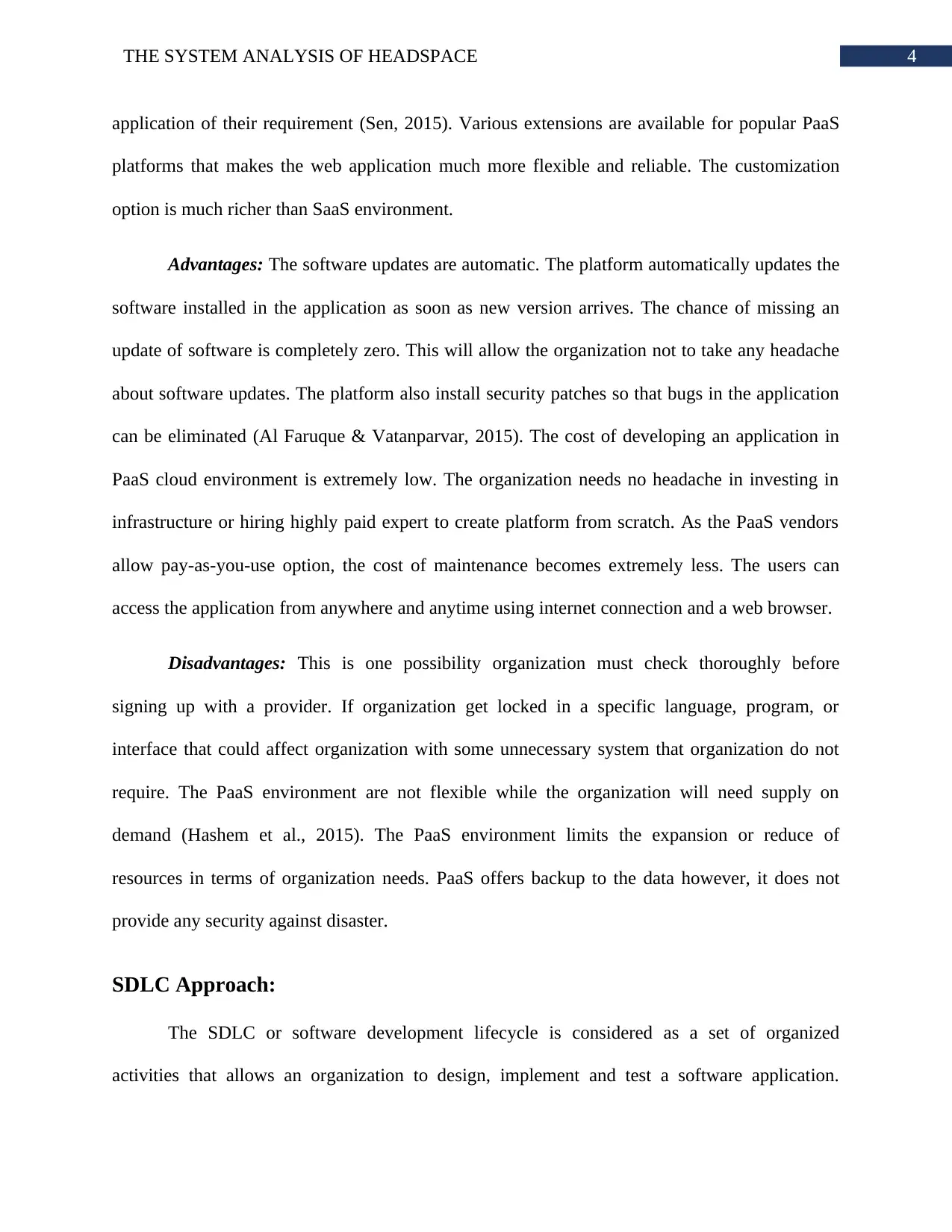
4THE SYSTEM ANALYSIS OF HEADSPACE
application of their requirement (Sen, 2015). Various extensions are available for popular PaaS
platforms that makes the web application much more flexible and reliable. The customization
option is much richer than SaaS environment.
Advantages: The software updates are automatic. The platform automatically updates the
software installed in the application as soon as new version arrives. The chance of missing an
update of software is completely zero. This will allow the organization not to take any headache
about software updates. The platform also install security patches so that bugs in the application
can be eliminated (Al Faruque & Vatanparvar, 2015). The cost of developing an application in
PaaS cloud environment is extremely low. The organization needs no headache in investing in
infrastructure or hiring highly paid expert to create platform from scratch. As the PaaS vendors
allow pay-as-you-use option, the cost of maintenance becomes extremely less. The users can
access the application from anywhere and anytime using internet connection and a web browser.
Disadvantages: This is one possibility organization must check thoroughly before
signing up with a provider. If organization get locked in a specific language, program, or
interface that could affect organization with some unnecessary system that organization do not
require. The PaaS environment are not flexible while the organization will need supply on
demand (Hashem et al., 2015). The PaaS environment limits the expansion or reduce of
resources in terms of organization needs. PaaS offers backup to the data however, it does not
provide any security against disaster.
SDLC Approach:
The SDLC or software development lifecycle is considered as a set of organized
activities that allows an organization to design, implement and test a software application.
application of their requirement (Sen, 2015). Various extensions are available for popular PaaS
platforms that makes the web application much more flexible and reliable. The customization
option is much richer than SaaS environment.
Advantages: The software updates are automatic. The platform automatically updates the
software installed in the application as soon as new version arrives. The chance of missing an
update of software is completely zero. This will allow the organization not to take any headache
about software updates. The platform also install security patches so that bugs in the application
can be eliminated (Al Faruque & Vatanparvar, 2015). The cost of developing an application in
PaaS cloud environment is extremely low. The organization needs no headache in investing in
infrastructure or hiring highly paid expert to create platform from scratch. As the PaaS vendors
allow pay-as-you-use option, the cost of maintenance becomes extremely less. The users can
access the application from anywhere and anytime using internet connection and a web browser.
Disadvantages: This is one possibility organization must check thoroughly before
signing up with a provider. If organization get locked in a specific language, program, or
interface that could affect organization with some unnecessary system that organization do not
require. The PaaS environment are not flexible while the organization will need supply on
demand (Hashem et al., 2015). The PaaS environment limits the expansion or reduce of
resources in terms of organization needs. PaaS offers backup to the data however, it does not
provide any security against disaster.
SDLC Approach:
The SDLC or software development lifecycle is considered as a set of organized
activities that allows an organization to design, implement and test a software application.

5THE SYSTEM ANALYSIS OF HEADSPACE
Various software development lifecycle models are available from which the organization can
chose specifically one that fits the project scope and objectives. The predictive SDLC is the
process of planning a project before it initiates. In predictive SDLC the requirements of system
are recognize before design process starts (Aljawarneh, Alawneh & Jaradat, 2017). However, in
adaptive SDLC, the few requirements are known prior to development but most of requirements
are gathered during project lifecycle. The adaptive SDLC is known to be more robust and was
developed to handle scope creep. On the other hand, if a new requirement is found in predictive
SDLC, the organization either have to start project from beginning or abandon the requirement.
In predictive SDLC each phase is completed once and using the information found is present
phase, the next phase is started. In adaptive SDLC each phases is completed in iteration. One
phase concentrate at one requirement at a time. Once a requirement reach testing phase, all the
phases in adaptive SDLC becomes active until the last requirement is completed.
Advantages of Predictive SDLC: The predictive SDLC can be easily managed and
followed. This SDLC model has specific time allocated to its phases and activities. All the tasks
has its resources planned. The outcome from each phase is also recognized. The use of
documentation in this model allows better tracking of activities. The predictive SDLC is known
to be suitable model for providing working solution within specific timeframe (Kumar, 2017).
The budget of the project can be easily calculated as the allocated resources and time to complete
each activity is known. The final product is known in predictive SDLC way before it is
completed. Predictive SDLC allows the organization to track each activities of the project.
Disadvantages of Predictive SDLC: The biggest disadvantage of predictive SDLC is its
forward movement. The organization cannot move backwards and adjust a change so that new
requirements can be added. The project moves only in forward direction and the only way to add
Various software development lifecycle models are available from which the organization can
chose specifically one that fits the project scope and objectives. The predictive SDLC is the
process of planning a project before it initiates. In predictive SDLC the requirements of system
are recognize before design process starts (Aljawarneh, Alawneh & Jaradat, 2017). However, in
adaptive SDLC, the few requirements are known prior to development but most of requirements
are gathered during project lifecycle. The adaptive SDLC is known to be more robust and was
developed to handle scope creep. On the other hand, if a new requirement is found in predictive
SDLC, the organization either have to start project from beginning or abandon the requirement.
In predictive SDLC each phase is completed once and using the information found is present
phase, the next phase is started. In adaptive SDLC each phases is completed in iteration. One
phase concentrate at one requirement at a time. Once a requirement reach testing phase, all the
phases in adaptive SDLC becomes active until the last requirement is completed.
Advantages of Predictive SDLC: The predictive SDLC can be easily managed and
followed. This SDLC model has specific time allocated to its phases and activities. All the tasks
has its resources planned. The outcome from each phase is also recognized. The use of
documentation in this model allows better tracking of activities. The predictive SDLC is known
to be suitable model for providing working solution within specific timeframe (Kumar, 2017).
The budget of the project can be easily calculated as the allocated resources and time to complete
each activity is known. The final product is known in predictive SDLC way before it is
completed. Predictive SDLC allows the organization to track each activities of the project.
Disadvantages of Predictive SDLC: The biggest disadvantage of predictive SDLC is its
forward movement. The organization cannot move backwards and adjust a change so that new
requirements can be added. The project moves only in forward direction and the only way to add
⊘ This is a preview!⊘
Do you want full access?
Subscribe today to unlock all pages.

Trusted by 1+ million students worldwide
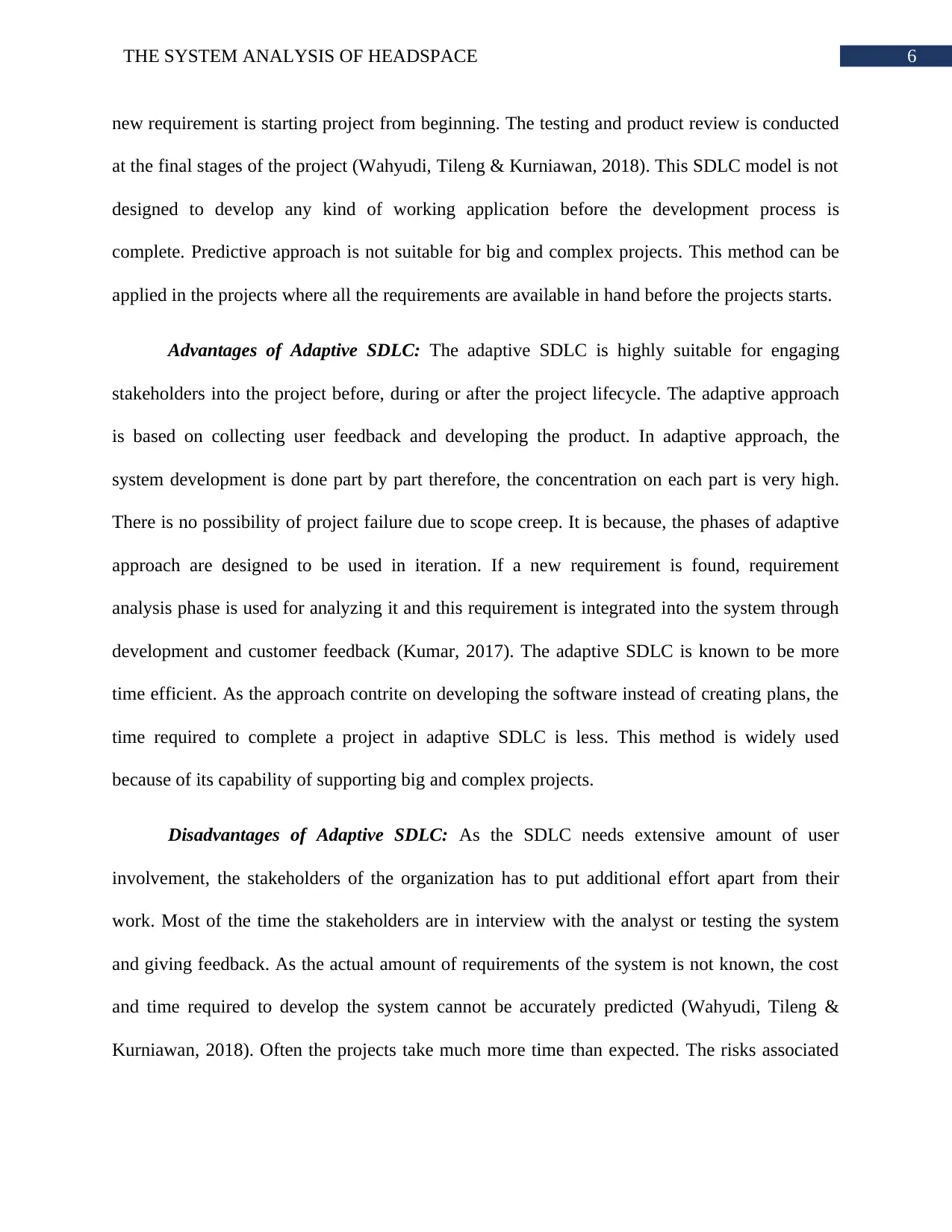
6THE SYSTEM ANALYSIS OF HEADSPACE
new requirement is starting project from beginning. The testing and product review is conducted
at the final stages of the project (Wahyudi, Tileng & Kurniawan, 2018). This SDLC model is not
designed to develop any kind of working application before the development process is
complete. Predictive approach is not suitable for big and complex projects. This method can be
applied in the projects where all the requirements are available in hand before the projects starts.
Advantages of Adaptive SDLC: The adaptive SDLC is highly suitable for engaging
stakeholders into the project before, during or after the project lifecycle. The adaptive approach
is based on collecting user feedback and developing the product. In adaptive approach, the
system development is done part by part therefore, the concentration on each part is very high.
There is no possibility of project failure due to scope creep. It is because, the phases of adaptive
approach are designed to be used in iteration. If a new requirement is found, requirement
analysis phase is used for analyzing it and this requirement is integrated into the system through
development and customer feedback (Kumar, 2017). The adaptive SDLC is known to be more
time efficient. As the approach contrite on developing the software instead of creating plans, the
time required to complete a project in adaptive SDLC is less. This method is widely used
because of its capability of supporting big and complex projects.
Disadvantages of Adaptive SDLC: As the SDLC needs extensive amount of user
involvement, the stakeholders of the organization has to put additional effort apart from their
work. Most of the time the stakeholders are in interview with the analyst or testing the system
and giving feedback. As the actual amount of requirements of the system is not known, the cost
and time required to develop the system cannot be accurately predicted (Wahyudi, Tileng &
Kurniawan, 2018). Often the projects take much more time than expected. The risks associated
new requirement is starting project from beginning. The testing and product review is conducted
at the final stages of the project (Wahyudi, Tileng & Kurniawan, 2018). This SDLC model is not
designed to develop any kind of working application before the development process is
complete. Predictive approach is not suitable for big and complex projects. This method can be
applied in the projects where all the requirements are available in hand before the projects starts.
Advantages of Adaptive SDLC: The adaptive SDLC is highly suitable for engaging
stakeholders into the project before, during or after the project lifecycle. The adaptive approach
is based on collecting user feedback and developing the product. In adaptive approach, the
system development is done part by part therefore, the concentration on each part is very high.
There is no possibility of project failure due to scope creep. It is because, the phases of adaptive
approach are designed to be used in iteration. If a new requirement is found, requirement
analysis phase is used for analyzing it and this requirement is integrated into the system through
development and customer feedback (Kumar, 2017). The adaptive SDLC is known to be more
time efficient. As the approach contrite on developing the software instead of creating plans, the
time required to complete a project in adaptive SDLC is less. This method is widely used
because of its capability of supporting big and complex projects.
Disadvantages of Adaptive SDLC: As the SDLC needs extensive amount of user
involvement, the stakeholders of the organization has to put additional effort apart from their
work. Most of the time the stakeholders are in interview with the analyst or testing the system
and giving feedback. As the actual amount of requirements of the system is not known, the cost
and time required to develop the system cannot be accurately predicted (Wahyudi, Tileng &
Kurniawan, 2018). Often the projects take much more time than expected. The risks associated
Paraphrase This Document
Need a fresh take? Get an instant paraphrase of this document with our AI Paraphraser
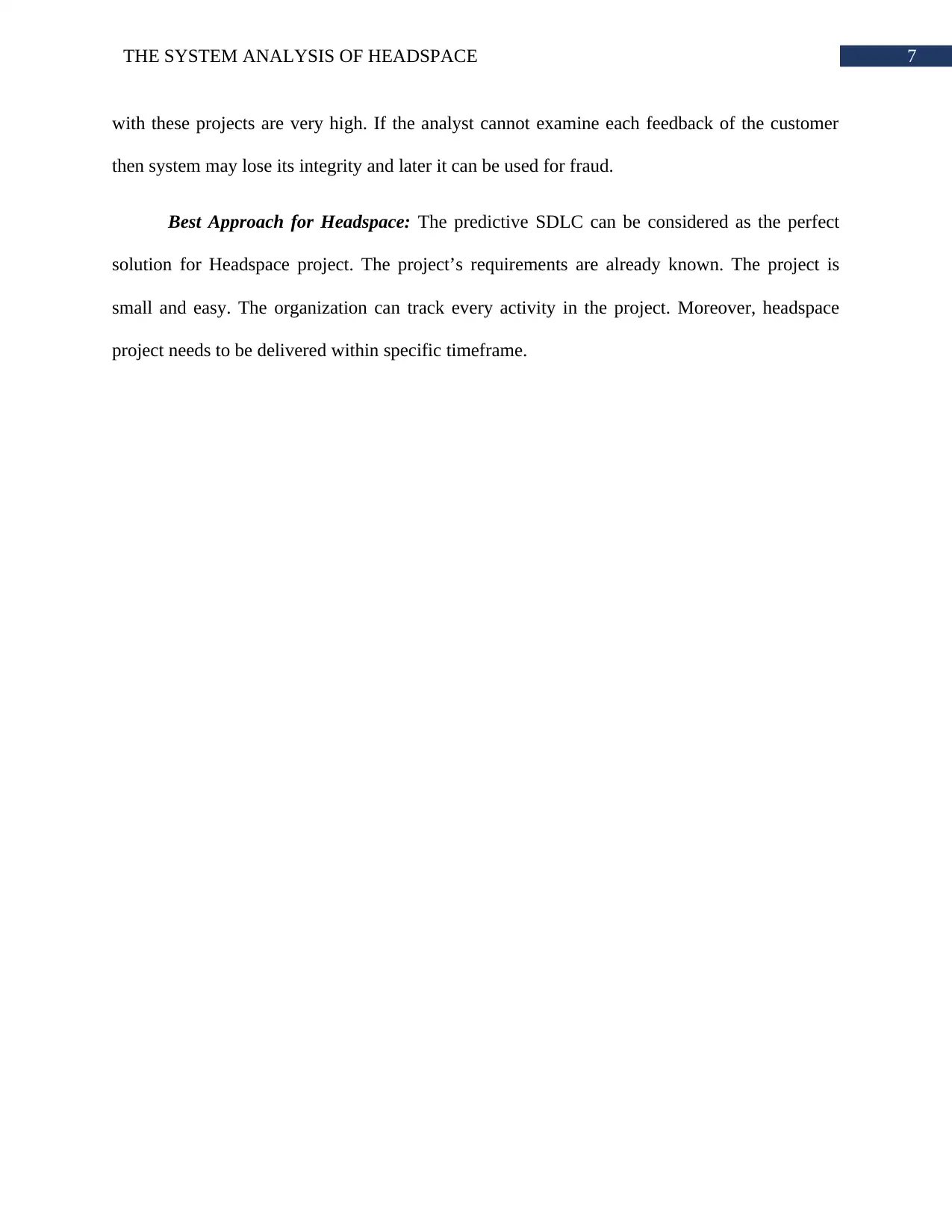
7THE SYSTEM ANALYSIS OF HEADSPACE
with these projects are very high. If the analyst cannot examine each feedback of the customer
then system may lose its integrity and later it can be used for fraud.
Best Approach for Headspace: The predictive SDLC can be considered as the perfect
solution for Headspace project. The project’s requirements are already known. The project is
small and easy. The organization can track every activity in the project. Moreover, headspace
project needs to be delivered within specific timeframe.
with these projects are very high. If the analyst cannot examine each feedback of the customer
then system may lose its integrity and later it can be used for fraud.
Best Approach for Headspace: The predictive SDLC can be considered as the perfect
solution for Headspace project. The project’s requirements are already known. The project is
small and easy. The organization can track every activity in the project. Moreover, headspace
project needs to be delivered within specific timeframe.
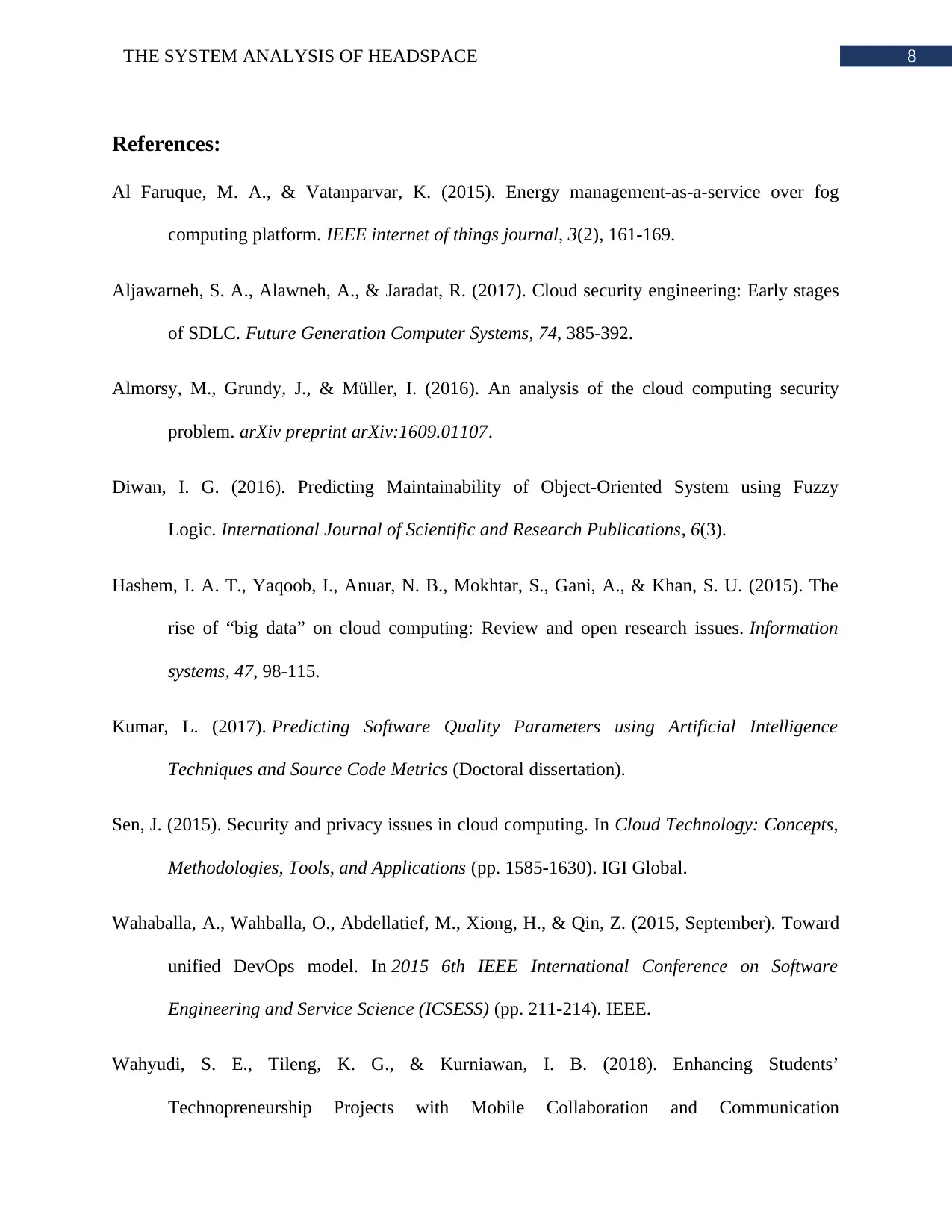
8THE SYSTEM ANALYSIS OF HEADSPACE
References:
Al Faruque, M. A., & Vatanparvar, K. (2015). Energy management-as-a-service over fog
computing platform. IEEE internet of things journal, 3(2), 161-169.
Aljawarneh, S. A., Alawneh, A., & Jaradat, R. (2017). Cloud security engineering: Early stages
of SDLC. Future Generation Computer Systems, 74, 385-392.
Almorsy, M., Grundy, J., & Müller, I. (2016). An analysis of the cloud computing security
problem. arXiv preprint arXiv:1609.01107.
Diwan, I. G. (2016). Predicting Maintainability of Object-Oriented System using Fuzzy
Logic. International Journal of Scientific and Research Publications, 6(3).
Hashem, I. A. T., Yaqoob, I., Anuar, N. B., Mokhtar, S., Gani, A., & Khan, S. U. (2015). The
rise of “big data” on cloud computing: Review and open research issues. Information
systems, 47, 98-115.
Kumar, L. (2017). Predicting Software Quality Parameters using Artificial Intelligence
Techniques and Source Code Metrics (Doctoral dissertation).
Sen, J. (2015). Security and privacy issues in cloud computing. In Cloud Technology: Concepts,
Methodologies, Tools, and Applications (pp. 1585-1630). IGI Global.
Wahaballa, A., Wahballa, O., Abdellatief, M., Xiong, H., & Qin, Z. (2015, September). Toward
unified DevOps model. In 2015 6th IEEE International Conference on Software
Engineering and Service Science (ICSESS) (pp. 211-214). IEEE.
Wahyudi, S. E., Tileng, K. G., & Kurniawan, I. B. (2018). Enhancing Students’
Technopreneurship Projects with Mobile Collaboration and Communication
References:
Al Faruque, M. A., & Vatanparvar, K. (2015). Energy management-as-a-service over fog
computing platform. IEEE internet of things journal, 3(2), 161-169.
Aljawarneh, S. A., Alawneh, A., & Jaradat, R. (2017). Cloud security engineering: Early stages
of SDLC. Future Generation Computer Systems, 74, 385-392.
Almorsy, M., Grundy, J., & Müller, I. (2016). An analysis of the cloud computing security
problem. arXiv preprint arXiv:1609.01107.
Diwan, I. G. (2016). Predicting Maintainability of Object-Oriented System using Fuzzy
Logic. International Journal of Scientific and Research Publications, 6(3).
Hashem, I. A. T., Yaqoob, I., Anuar, N. B., Mokhtar, S., Gani, A., & Khan, S. U. (2015). The
rise of “big data” on cloud computing: Review and open research issues. Information
systems, 47, 98-115.
Kumar, L. (2017). Predicting Software Quality Parameters using Artificial Intelligence
Techniques and Source Code Metrics (Doctoral dissertation).
Sen, J. (2015). Security and privacy issues in cloud computing. In Cloud Technology: Concepts,
Methodologies, Tools, and Applications (pp. 1585-1630). IGI Global.
Wahaballa, A., Wahballa, O., Abdellatief, M., Xiong, H., & Qin, Z. (2015, September). Toward
unified DevOps model. In 2015 6th IEEE International Conference on Software
Engineering and Service Science (ICSESS) (pp. 211-214). IEEE.
Wahyudi, S. E., Tileng, K. G., & Kurniawan, I. B. (2018). Enhancing Students’
Technopreneurship Projects with Mobile Collaboration and Communication
⊘ This is a preview!⊘
Do you want full access?
Subscribe today to unlock all pages.

Trusted by 1+ million students worldwide
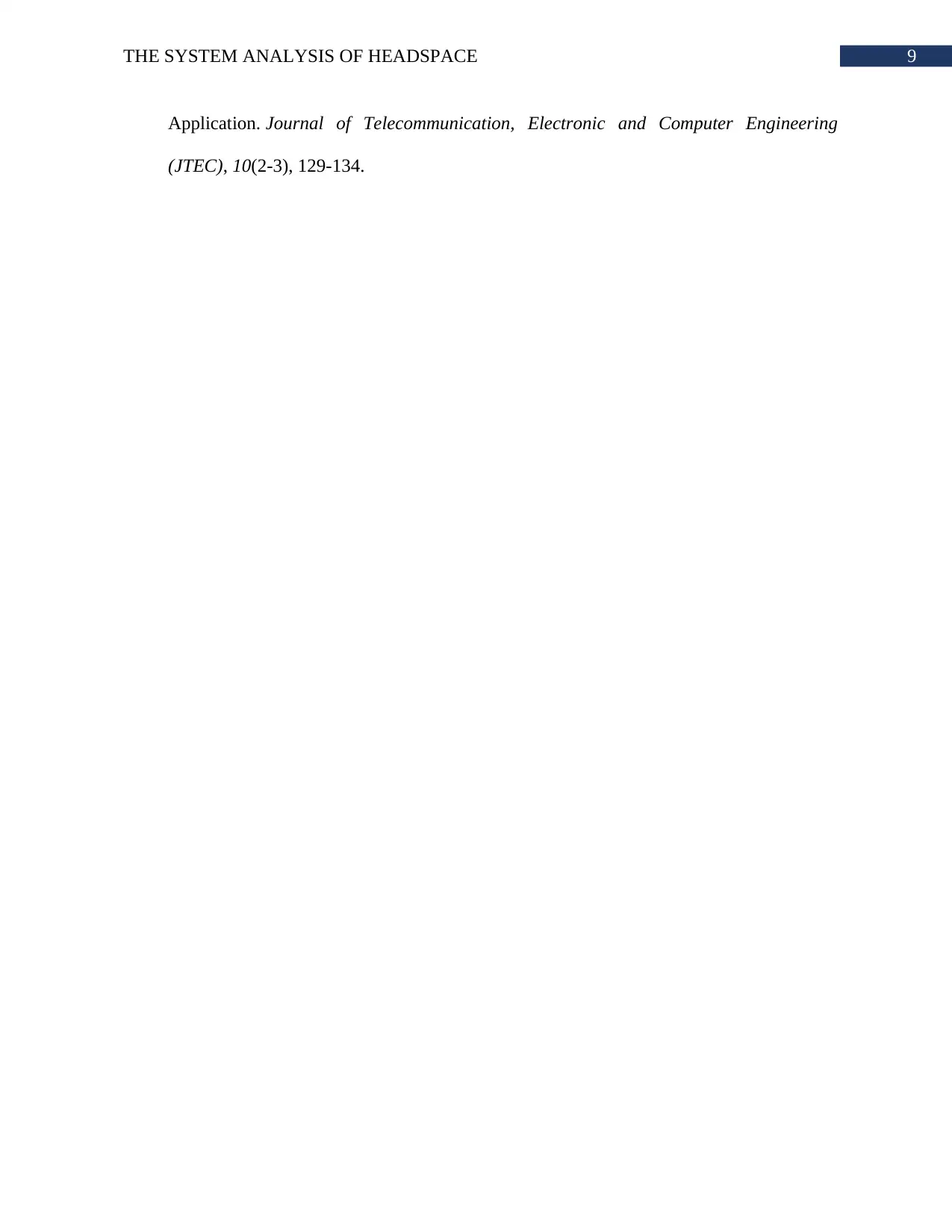
9THE SYSTEM ANALYSIS OF HEADSPACE
Application. Journal of Telecommunication, Electronic and Computer Engineering
(JTEC), 10(2-3), 129-134.
Application. Journal of Telecommunication, Electronic and Computer Engineering
(JTEC), 10(2-3), 129-134.
1 out of 10
Related Documents
Your All-in-One AI-Powered Toolkit for Academic Success.
+13062052269
info@desklib.com
Available 24*7 on WhatsApp / Email
![[object Object]](/_next/static/media/star-bottom.7253800d.svg)
Unlock your academic potential
Copyright © 2020–2025 A2Z Services. All Rights Reserved. Developed and managed by ZUCOL.




